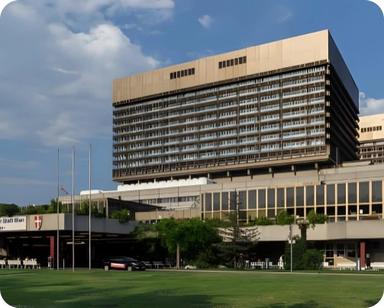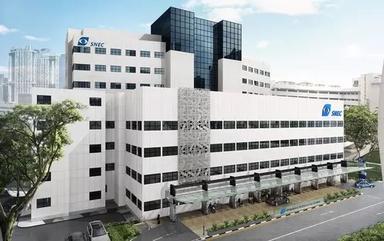الحزم تبدأ من
$7000
هل تحتاج إلى مساعدة في اختيار الحزمة المناسبة لرحلتك الطبية؟
بياناتك الصحية محمية معنا

تحويل الحياة بـ رأب الصفيحة الشوكية واستئصال الأورام بالجراحة المجهرية
شد الشوكة الشوكي ، واستئصال الورم المجهرية ، وهما تقنيتان جراحيتان متقدمتان غالبًا ما يتم استخدامه في تركيبة لعلاج أورام العمود الفقري مع الحفاظ على وظائف الحبل الشوكي وربما تحسينها.
نظرة عامة على عملية تجميل الصفيحة:
- غاية: عملية تصغير العمود الفقري هي عملية جراحية لتخفيف الضغط على العمود الفقري تتضمن إعادة تشكيل أو "إعادة بناء" الفقرات لتوفير مساحة أكبر للحبل الشوكي. على عكس استئصال الصفيحة الفقرية، الذي يزيل الصفيحة بأكملها (الجزء الخلفي من الفقرة)، فإن عملية رأب الصفيحة الفقرية تقوم بربط العظام أو إعادة تشكيلها للحفاظ على استقرار العمود الفقري وحماية الحبل الشوكي.
- دواعي الإستعمال: يستخدم عادة لتضيق العمود الفقري العنقي أو في الحالات التي قد تؤدي فيها إزالة الصفيحة بالكامل إلى عدم استقرار لا داعي له.
نظرة عامة على استئصال الورم الجراحي:
- تقنية: يتضمن ذلك استخدام طرق الجراحة المجهرية لإزالة الأورام بدقة ودقة داخل الحبل الشوكي أو بجواره. وباستخدام التكبير العالي والأدوات الدقيقة، يستطيع الجراحون تقليل الضرر الذي يلحق بالأنسجة السليمة المحيطة.
- غاية: لإزالة النمو الورمي الذي يضغط على الحبل الشوكي أو الأعصاب، وبالتالي تخفيف الأعراض ومنع المزيد من الضرر العصبي.
نهج مشترك:
- إن استخدام عملية تجميل الصفيحة بالتزامن مع استئصال الورم بالجراحة المجهرية يسمح للجراحين بالوصول إلى الأورام وإزالتها بشكل فعال مع معالجة أي عدم استقرار محتمل في العمود الفقري بعد الاستئصال على الفور.
فوائد:
- الحفاظ الوظيفي: يهدف كلا الإجراءين إلى الحفاظ على أكبر قدر ممكن من وظائف الحبل الشوكي والأعصاب.
- تخفيف الأعراض: فعال في تقليل الألم والعجز الحسي والخلل الحركي الناجم عن الضغط.
- السلامة الهيكلية: تساعد عملية تجميل الصفيحة في الحفاظ على سلامة وقوة العمود الفقري.
استعادة:
- يتضمن الانتعاش إقامة في المستشفى ، وربما يتبعه إعادة التأهيل بما في ذلك العلاج البدني والمهني. يمكن أن يختلف مسار التعافي المحدد بناءً على مدى الجراحة والعوامل الفردية للمريض.
النتائج:
- الهدف هو تحقيق أقصى قدر من إزالة الورم مع الحد الأدنى من التأثير على الوظيفة العصبية والاستقرار الشوكي. هذه الإجراءات يمكن أن تحسن بشكل كبير من نوعية الحياة والنتائج الوظيفية للمرضى.
من خلال الجمع بين عملية تجميل الصفيحة الفقرية واستئصال الورم بالجراحة المجهرية، يمكن للجراحين معالجة أورام العمود الفقري المعقدة مع الحفاظ على السلامة الهيكلية والوظيفية للعمود الفقري.
5.0
94% مصنف قيمة مقابل المال
لماذا تختارونا؟
99%
معدل النجاح
0
رأب الصفيحة الشوكية واستئصال الأورام بالجراحة المجهرية الجراحين
0
رأب الصفيحة الشوكية واستئصال الأورام بالجراحة المجهرية
0
المستشفيات في جميع أنحاء العالم
0
الحياة التي تم لمسها
نظرة عامة
شد الشوكة الشوكي ، واستئصال الورم المجهرية ، وهما تقنيتان جراحيتان متقدمتان غالبًا ما يتم استخدامه في تركيبة لعلاج أورام العمود الفقري مع الحفاظ على وظائف الحبل الشوكي وربما تحسينها.
نظرة عامة على عملية تجميل الصفيحة:
- غاية: عملية تصغير العمود الفقري هي عملية جراحية لتخفيف الضغط على العمود الفقري تتضمن إعادة تشكيل أو "إعادة بناء" الفقرات لتوفير مساحة أكبر للحبل الشوكي. على عكس استئصال الصفيحة الفقرية، الذي يزيل الصفيحة بأكملها (الجزء الخلفي من الفقرة)، فإن عملية رأب الصفيحة الفقرية تقوم بربط العظام أو إعادة تشكيلها للحفاظ على استقرار العمود الفقري وحماية الحبل الشوكي.
- دواعي الإستعمال: يستخدم عادة لتضيق العمود الفقري العنقي أو في الحالات التي قد تؤدي فيها إزالة الصفيحة بالكامل إلى عدم استقرار لا داعي له.
نظرة عامة على استئصال الورم الجراحي:
- تقنية: يتضمن ذلك استخدام طرق الجراحة المجهرية لإزالة الأورام بدقة ودقة داخل الحبل الشوكي أو بجواره. وباستخدام التكبير العالي والأدوات الدقيقة، يستطيع الجراحون تقليل الضرر الذي يلحق بالأنسجة السليمة المحيطة.
- غاية: لإزالة النمو الورمي الذي يضغط على الحبل الشوكي أو الأعصاب، وبالتالي تخفيف الأعراض ومنع المزيد من الضرر العصبي.
نهج مشترك:
- إن استخدام عملية تجميل الصفيحة بالتزامن مع استئصال الورم بالجراحة المجهرية يسمح للجراحين بالوصول إلى الأورام وإزالتها بشكل فعال مع معالجة أي عدم استقرار محتمل في العمود الفقري بعد الاستئصال على الفور.
فوائد:
- الحفاظ الوظيفي: يهدف كلا الإجراءين إلى الحفاظ على أكبر قدر ممكن من وظائف الحبل الشوكي والأعصاب.
- تخفيف الأعراض: فعال في تقليل الألم والعجز الحسي والخلل الحركي الناجم عن الضغط.
- السلامة الهيكلية: تساعد عملية تجميل الصفيحة في الحفاظ على سلامة وقوة العمود الفقري.
استعادة:
- يتضمن الانتعاش إقامة في المستشفى ، وربما يتبعه إعادة التأهيل بما في ذلك العلاج البدني والمهني. يمكن أن يختلف مسار التعافي المحدد بناءً على مدى الجراحة والعوامل الفردية للمريض.
النتائج:
- الهدف هو تحقيق أقصى قدر من إزالة الورم مع الحد الأدنى من التأثير على الوظيفة العصبية والاستقرار الشوكي. هذه الإجراءات يمكن أن تحسن بشكل كبير من نوعية الحياة والنتائج الوظيفية للمرضى.
من خلال الجمع بين عملية تجميل الصفيحة الفقرية واستئصال الورم بالجراحة المجهرية، يمكن للجراحين معالجة أورام العمود الفقري المعقدة مع الحفاظ على السلامة الهيكلية والوظيفية للعمود الفقري.















